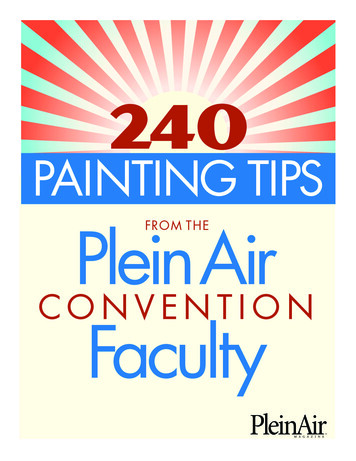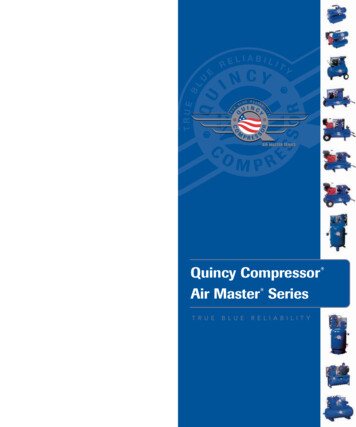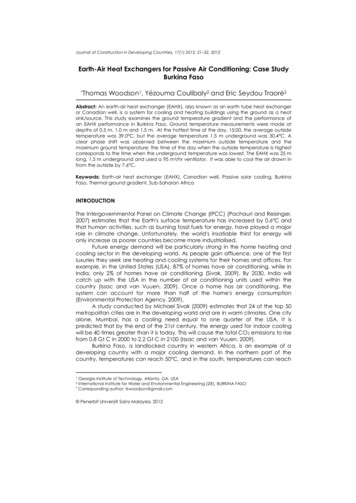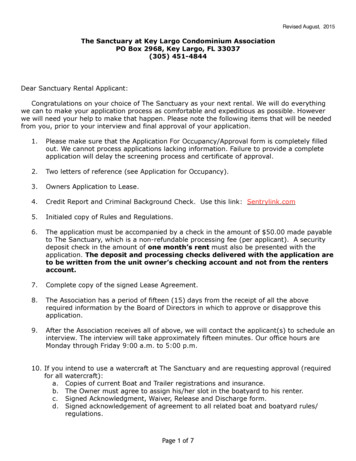
Transcription
Dear Plein Air Enthusiast:PleinAir magazine is happy to present you with 240 Painting Tips from the faculty of the past several years of thePlein Air Convention. There is a wealth of knowledge and experience on these pages from a small sampling of theinstructors who have participated with us at the convention.We love the art of painting outdoors, plein air being the French term, originally assigned to the impressionists, forthose who paint outdoors. Today’s movement is huge, with thousands of outdoor landscape, portrait, and evenstill life painters painting from life outdoors and in the studio. Since we began publishing, hundreds of plein airevents have begun around the world. Thousands of individuals have become plein air collectors and painters,and specialty galleries are seemingly popping up everywhere. We’re proud to have played a small roll in thismovement and are excited about seeing it continue.You can become a part of this movement, too —by learning to paint, growing as a painter, or collectingoutdoor paintings. We offer several options to help you embrace the movement: PleinAir magazine —subscribe at PleinAirMagazine.com or call 800.610.5771 PleinAir Today weekly newsletter — FREE at OutdoorPainter.com The Plein Air Convention & Expo — PleinAirConvention.com The PleinAir Salon art competition —PleinAirSalon.com Streamline Art Video—instructional art videos on learning to paint —StreamlineArtVideo.comIf you’re not a painter, YOU CAN LEARN. You do not have to have natural talent to become a good painter. Weencourage you to find a local painter to study, look at the techniques in our magazine and videos, or attend oureducational events like the Plein Air Convention. You can do it!Plein air is the new golf. Why? It’s fun, it’s challenging, you get to be outdoors, you get to go to exotic and beautifulplaces to paint, and it’s very social. You’ll make lots of new friends and become a part of this burgeoning community.Join the movement!Eric Rhoads,PublisherPS: I hope you like our 240 tips. You may also like our magazine Fine Art Connoisseur (FineArtConnoisseur.com),which is about the contemporary and historical art movement in America and the world today. We feature collections,the stories of art, the artists making their mark, the historic artists and their stories, and lots of beautiful imagesof paintings. We hope you’ll consider subscribing. 2019 Streamline Publishing, Inc. All Rights Reserved.
240PAINTING TIPSB. ERIC RHOADSPleinAir Magazine PublisherWhile everyone else is offering you tips on painting, my goal is to help those who want tosell their paintings sell more of them. In my Art Marketing Boot Camp Series ( I-VI),I outline the basics of art marketing. Here are a couple of ideas.1. If you build it, they won’t come: There is a misconception that any great artist will eventually be discoveredand sell well, yet the world is littered with highly accomplished, unknown artists. A few get lucky and are “discovered,”but that is rare. Most great artists who sell do so because they make consistent marketing efforts. To sell, youneed a marketing plan, a life plan, an effort that requires devoting about one out of five workdays to marketing.2. The three-legged stool of all marketing is media, message, and market. You have to present the rightmessage, and reach the right market. When advertising fails, most people blame the media, when that’s oftennot the problem. If you’re “getting no calls” or Web visits, ask how the media you’re using can possibly survive ifit doesn’t work. The reality is that it does work, and the problem is with your message — in the content, and possiblyin the targeting of your market. Most ads fail because someone assumes running an ad one or two times will work.Ads require repetition over long periods of time. Other ads fail because people are copying what they’ve seenothers do rather than writing an ad that grabs attention and includes a call to action.3. No ad should have a single purpose. Most artists put a single painting in an ad, hoping there’s one buyer outthere who likes it. But what if there isn’t? You do shows with multiple paintings, and sometimes none of them sell.This is no different. Your ad should have a capture device designed to pull people to your website to sign up forsomething, so you can place them in your sales process beyond your ads.4. You can’t get where you’re going without a map. Most people advertise and don’t know why. They simplytell themselves they want to sell more. Rarely do they have a plan, nor any idea of what they want to achieve,what their brand should be, or the purpose of it all beyond just selling. I outline this in my Marketing Boot Camp I,explaining how to design a life plan so you can build your marketing plan around it. You need to design your ideallife, decide what you need to accomplish that life, and then build a plan to meet those needs.KELLY KANEPleinAir Magazine Editor-in-Chief5. When looking at your painting subject, squint so you see only large areas of value and not the smallOutdoorPainter.com3
details. Paint from big shapes to smaller ones so your painting has unity and focus. Judge each new color mixtureagainst what you’ve already painted, asking yourself if the new strokes of paint need to be warmer or cooler,darker or lighter, than the paint already on the canvas.6. Stand back from your painting in progress so you see the overall image and not just the up-close details.7. Try different painting surfaces, brushes, mediums, and solvents to determine which combination feels bestfor you. After completing 10 plein air paintings, look at them all together to judge your progress, emerging style,and new challenges.KEN AUSTER8. Spend more time understanding what you are trying to paint. Edit out anything that you cannot understandintellectually. Define the focal point — the hook, the thing that caught your eye. Build the painting around the focalpoint like a spider web. The closer you are to the focal point, the tighter the brushwork, and the further from thefocal point, the looser it gets. All roads lead to the focal point; no jumping around the painting.STEFAN BAUMAN9. Paint what you love. When painting what you love, ask more deeply what it is that you love about it. The light? Thecolor? Is it the pattern it makes, the shadow or contrast? Or how cool or light it is? Getting to the root of understandingyour world will get you in touch with your inner artist and developing a style of your own. Ask yourself, “What is herethat I love?” Not just like. See if you can love one thing about the scene. Now communicate that intense feelingto the viewer. Don’t stop on location, take out your paint, and slosh it on until all the white space is covered. It’snot a race to see who can paint it faster. Painting is communicating, but make sure you have something to say.10. Sketch quickly, first in value. When painting outdoors, it is important that you capture the drawing first.Many students hurry this process, but I feel that this must be done. Start with an earth color and cobalt blue toestablish the drawing, along with warms and cools. This is the most important part of the painting because it setsthe tone and values, so as the light changes throughout the day, you can place “footnotes” on where the light isby wiping out highlights with a paper towel.11. Vision and technique are the only two disciplines that, when learned and improved upon, will make thepursuit of art more passionate and the journey more enjoyable. Artists can achieve greatness by learningOutdoorPainter.com4
techniques and using them to promote their vision. With these two elements, an artist’s reputation can go on forever.BRENDA BOYLAN12. Practice setting up your easel a few times before your first outing. Navigating an umbrella can be a humorousendeavor for others to observe, so practice where and how to hook it up to avoid frustration and wasted time.13. Your first mark should be the horizon line. This grounds your painting and immediately navigates the space.14. When dressing for the outing, think thin-to-thick. Wear layers of clothing to avoid colder-than-expectedor steaming hot conditions.15. Painting outdoors is a little like camping. Be courteous and respectful with nature and your fellow painterswhile out painting. If you are in a very wild area, expect natural things to happen. Bug bites, wildlife, unexpectedweather conditions, or a potential angry farmer, as well as the best painting subject matter, are all part of the pleinair experience. Leave no trace behind.16. Have a sense of humor at the easel. This keeps things simple and not overworked — not to mention, the“fun factor” is definitely increased.RYAN S. BROWN17. Self-critiquing is perhaps the most helpful skill that one develops in one’s training. The main purposeof good training is to help students become self-sufficient in their knowledge and capable of achieving theirpotential as artists.In my experience, mastery in drawing is absolutely the most important factor and the first step towarddeveloping the visual clarity that allows you to critique your own work.Learn to see the whole — all elements in a work must work in harmony to support the whole.Use your mirror. This helps provide a mental separation with the piece that brings clarity.Learn to see it as it is, and not how it was — separate yourself from the small steps that made the workbetter in order to see whether it is fully resolved yet. Self-critiquing is difficult because we see everything thatOutdoorPainter.com5
has gone into the piece. When we make a change or a correction, it is easy to convince ourselves that it’s right,or that it’s fully resolved, because we see how much better it looks than it did in previous stages. It’s necessaryto blind yourself to how much better it looks and see it as though you’ve never looked at it before. Try tofigure out whether it’s fully resolved or if it still needs some adjusting.Good drawing is a product of good understanding — it is easy to see in a final painting how well the artist understoodhis subject. You cannot define something you do not understand. In the initial stages of a drawing or painting, weconcentrate on the flat, abstract explanation of a subject, or how the shapes, rhythms, and proportions look. Animportant transition in our thinking leads us to why the shapes look like they do. This “why” helps bring us to afully realized, sculptural explanation of the subject.Never knowingly leave anything wrong on the canvas.Take breaks and rest your eyes — and after a break, don’t come back and pick up where you left off. Lookfor the worst thing in the painting, and attack that. This forces you to assess the whole of the painting andlook for the areas that negatively affect the visual impression of the painting.Self-critiquing will only get you most of the way there. Always ask someone whose eyes you respect. Don’tassume you can pull it off by yourself. Painting is hard enough; don’t cheat yourself out of a needed pair of fresheyes and a fresh perspective. Your painting deserves every opportunity to be as brilliant as it can be. Greatness isnever achieved alone.MICHELE BYRNE18. Painting should reflect your passions and obsessions —look deep inside yourself for inspiration.19. Have the right tools for painting and setup — ask advice from other artists. Also, have the right possessionsin your life. An artist should have less, not more.20. It is not necessary to finish a painting in one session. Looking at waterfalls and fast-running rivers, viewingthe horizon, looking at the stars — they’re all important to the plein air painter.There is much to do in life. As an artist, the best way to spend your time is at the easel. However, an artist’s lifecannot be scheduled as a job. Time alone, time for reflection, is all-important.Artists have to learn to forgive, especially themselves.OutdoorPainter.com6
LARRY CANNON21. You will learn far more from your failures than you will from your successes. You will always rememberthe mistakes, while sometimes you will have no idea how to repeat the successes.Look at any great artist in history. Only about 10 percent of their paintings rise to the exceptional level. Youshouldn’t expect every painting to be frameable. You are probably not going to be in the art history books, sorelax, learn, and follow your passion.An honest interpretation of what you see is far better than a copy of some other artist’s style.At any point in your progress, you are truly only at the beginning of your learning curve.22. Learn to look, look to learn. Your painting will always look inadequate when placed in front of your subject.It will only sing when viewed away from direct comparison with Nature’s magnificence.JOHN D. COGAN23. Never lose your passion for painting. Each of us as an artist fell in love with line, with shape, with color. Takepleasure in using these to create more beauty. Enjoy the line as it follows the pencil point, indulge the sensuousflow of paint as you layer thick color onto the canvas, feel the form as you mold it in clay. Love what you do asan artist, and you cannot help but do it well.24. Remember that as an artist, you are telling a story. Think about why the story interests you, and concentrateon those aspects that will make it interesting for those who will look at your painting.25. When working in plein air, start with your most important elements. Get your center of interest right,and everything else will fall into place. Don’t begin with the less important things; the light you fell in love withwhen you set up may quickly be gone. But if you go for the center of interest first and get it right, you can makeeverything else work with it no matter what the light does after that. Even if you don’t finish the painting, if youleave white patches on the canvas, you will get what you came for, and a good painting will be your reward.26. Learn to draw. No matter what me
PleinAir magazine is happy to present you with 240 Painting Tips from the faculty of the past several years of the Plein Air Convention. There is a wealth of knowledge and experience on these pages from a small sampling of the instructors who have participated with us at the convention. We love the art of painting outdoors, plein air being the French term, originally assigned to the .











